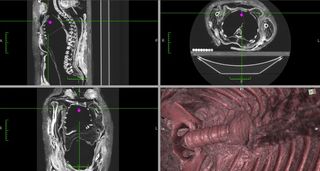
Contrary to reports by famous Greek historian Herodotus, the ancient Egyptians probably didn't remove mummy guts using cedar oil enemas, new research on the reality of mummification suggests.
The ancient embalmers also didn't always leave the mummy's heart in place, the researchers added.
The findings, published in the February issue of HOMO – Journal of Comparative Human Biology, come from analyzing 150 mummies from the ancient world.
Mummy history
In the fifth century B.C., Herodotus, the "father of history," got an inside peek at the Egyptian mummification process. Embalming was a competitive business, and the tricks of the trade were closely guarded secrets, said study co-author Andrew Wade, an anthropologist at the University of Western Ontario.
Herodotus described multiple levels of embalming: The elites, he said, got a slit through the belly, through which organs were removed. For the lower class, mummies had organs eaten away with an enema of cedar oil, which was thought to be similar to turpentine, Herodotus reported. [See Images of Egyptian Mummification Process]
In addition, Herodotus claimed the brain was removed during embalming and other accounts suggested the heart was always left in place.
Sign up for the Live Science daily newsletter now
Get the world’s most fascinating discoveries delivered straight to your inbox.
"A lot of his accounts sound more like tourist stories, so we're reticent to take everything he said at face value," Wade told LiveScience.
Mummy tales
To see how eviscerations really took place, Wade and his colleague Andrew Nelson looked through the literature, finding details on how 150 mummies were embalmed over thousands of years in ancient Egypt. They also conducted CT scans and 3D reconstructions on seven mummies.
The team found that rich and poor alike most commonly had the transabdominal slit performed, although for the elites evisceration was sometimes performed through a slit through the anus.
In addition, there wasn't much indication that cedar oil enemas were used.
Only a quarter of mummies had their hearts left in place. The removal of the heart seems to coincide with the transition period when the middle class gained access to mummification, so getting to keep the heart may have become a status symbol after that point, Wade said.
"The elites need some way to distinguish themselves from the people that they're ruling," he said.
And whereas Herodotus had suggested mummies had their brains removed and discarded, Wade and his colleagues found about a fifth of the brains were left inside the mummies' skulls. Almost all the others were pulled out through the nose, Wade's team described in another study detailed in the August 2011 issue of the same journal
After the evisceration, the bodies were rubbed down with a mild antiseptic such as palm wine. They were also covered with packets of natron, a naturally occurring salt, left to dry out for many days, packed with linen or wood shavings, and sometimes perfumed with scented items, Wade said.
Varied traditions
The findings show just how varied embalming techniques were in the ancient world, said David Hunt, a physical anthropologist at the Smithsonian Institution in Washington, D.C.
"A lot of people have taken the idea that it was all done the same way, but over the course of 3,000 years? Heck no," Hunt told LiveScience. "We know that folks in the Sudan didn't follow the exact same methodology as people that were in Alexandria."
Follow Tia Ghose on Twitter @tiaghose. Follow LiveScience @livescience, Facebook & Google+. Original article on LiveScience.com

Tia is the managing editor and was previously a senior writer for Live Science. Her work has appeared in Scientific American, Wired.com and other outlets. She holds a master's degree in bioengineering from the University of Washington, a graduate certificate in science writing from UC Santa Cruz and a bachelor's degree in mechanical engineering from the University of Texas at Austin. Tia was part of a team at the Milwaukee Journal Sentinel that published the Empty Cradles series on preterm births, which won multiple awards, including the 2012 Casey Medal for Meritorious Journalism.
Most Popular


